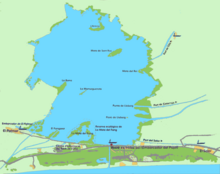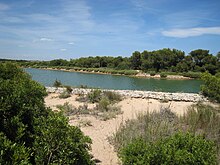Parc Natural de l'Albufera de València
|
Parc Natural de l'Albufera de València
|
||
| location | Valencia , Valencia Province , Valencian Community , Spain | |
| surface | 21.1 km² | |
| WDPA ID | 68187 | |
| Geographical location | 39 ° 20 ′ N , 0 ° 21 ′ W | |
|
|
||
| Setup date | 5th December 1989 | |
| administration | Generalitat Valenciana | |
The Albufera [ albuˈfeɾa ] ( Valencian for “lagoon”, from the Arabic البحيرة al-buhayra, “little sea”) or Parc Natural de l'Albufera de València , is a natural park on the Spanish Mediterranean coast . It is named after the Albufera beach lake (a sweetened lagoon ) in the core of the area and also includes the extensive marshland surrounding it and the Devesa (or Pinedo ) beach forest on the spit on the Gulf of Valencia in eastern Spain . The nature park is home to a wide variety of flora and fauna that can be observed all year round. The former salt water lagoon was converted into fresh water by irrigation and canals and the ever-growing sandbanks by the 17th century.
geography
The natural park is only 11 kilometers south of Valencia , in the municipal areas of 13 cities and four former cities bordering the capital, which in turn are in four comarcas (districts),
- namely in Horta Sud: Albal, Alfafar, Beniparrell, Catarroja, Massanassa, Sedaví and Silla;
- in the Ribera Baixa: Albalat de la Ribera, Cullera, Sollana, Sueca and El Mareny de Barraquetes;
- in the Ribera Alta: Algemesí;
- and in the greater Valencia area: Pinedo, El Palmar, El Saler and El Perellonet.
The proximity to the state capital enables many people to experience nature or watch birds there.
Since 1990, the Albufera has been included as a Ramsar area in the list of wetlands of international importance for birds, which was established in the UN Convention of 1971. Since 1991 the Parc Natural de l'Albufera de València has also been a European bird sanctuary ( ZEPA in Spain ) and thus part of the Natura 2000 network of the European Union .
fishing
The main human use of the lagoon was and is fishing.
history
The rich fish population has attracted people there since prehistoric times. Fishing was recognized by law in 1250 when the El Palmar Fisheries Association established a regime that was then applied to the Silla and Catarroja fisheries.
today
Until the beginning of the industrialization of the lagoon catchment area, fishing brought considerable profits, as the clean water of the lake offered a great variety and a great wealth of animals ( freshwater shrimp , "Petxinot" ( Unio elongatus ), eels, perches, etc.).
Currently, perch and eel stocks have declined significantly, while mullets and blue crabs (a species introduced in the 1980s) have increased.
Agriculture
The area has been used for rice cultivation since the 18th century. It is of great economic and ecological importance as species of flora and fauna that have disappeared from the lake itself still live in the rice fields (where the lagoon waters are purified). These rice fields also provide food and shelter for many birds.
Microbes
The Albufera is heavily dominated by cyanobacteria , especially Synechococcus .
Web links
- Parc Natural de L'albufera de València
- English audio guide (40 chapters of about 2 minutes each)
Individual evidence
- ↑ Albufera de Valencia . Retrieved April 25, 2018.
- ^ Rohit Ghai: Metagenomes of Mediterranean Coastal Lagoons . In: Scientific Reports . 2, 2012, p. 490. doi : 10.1038 / srep00490 . PMID 22778901 . PMC 3391805 (free full text).





